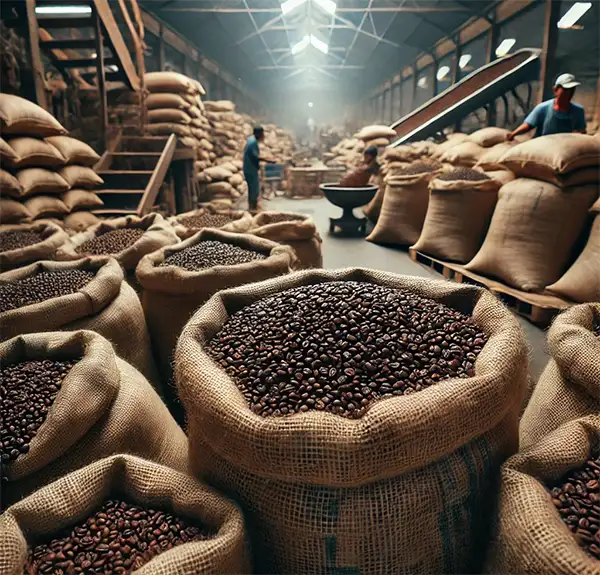What Exactly is International Coffee Day?
Celebrated annually on October 1st, International Coffee Day is a global celebration of one of the most popular beverages in the world. It's a day to appreciate everything coffee does for us—whether it’s the warm cup that greets you in the morning, the iced latte that helps you survive a long meeting, or the espresso shot that fuels your inner superhero. Coffee not only boosts your energy but also unites people from all walks of life. You’ll find it in cafés, homes, offices, and even roadside stands, brewing up connections as well as caffeine.
International Coffee Day was launched by the International Coffee Organization (ICO) in 2015 to not only celebrate the beverage itself but also to raise awareness about the challenges faced by coffee farmers around the world. The focus is on promoting sustainable coffee practices, ensuring that both the environment and the workers who make our morning cup possible are treated with care.
A Brew for the Ages
Coffee’s origin story is one for the books, or at least for a great chat over a cappuccino. Legend has it that coffee was first discovered in Ethiopia when a curious goat herder named Kaldi noticed his goats dancing and buzzing around with excitement after nibbling on the red berries of a coffee plant. Curious, Kaldi tried the berries himself and soon found he had a bit more pep in his step too. Word spread, and soon the monks at local monasteries were using the berries to stay awake during long prayers—because even monks need a little pick-me-up!
From Ethiopia, coffee traveled to Yemen, where it became a staple in Sufi monasteries. By the 15th century, coffee houses, known as "qahveh khaneh," were springing up in the Middle East. These were early versions of today’s cafés—social hubs where people gathered to sip coffee, discuss ideas, and occasionally, you know, overthrow a government or two.
By the 17th century, coffee made its way to Europe, where it was initially met with suspicion (because, really, anything that wakes you up before noon had to be witchcraft). But soon enough, coffee houses became the hot spot for intellectuals, writers, and anyone looking for a good debate. By the time coffee reached the New World, it had cemented itself as the drink of choice for revolutionaries, intellectuals, and anyone trying to escape the tyranny of early bedtimes.
How Coffee Took Over the World (And Your Mornings)
If you’ve ever wondered how coffee went from being a drink for monks and scholars to a global phenomenon, the answer is simple: caffeine. That little chemical compound is basically nature’s way of saying, “You’ve got this!” In fact, coffee is the second most traded commodity in the world after oil, which makes sense—both are fuels, just for different kinds of engines.
 Today, coffee is a multibillion-dollar industry. It’s consumed in nearly every country, often with its own cultural twist. In Italy, espresso is practically a religion. In Turkey, coffee is brewed thick enough to practically stand a spoon in it, and fortunes are told from the grounds. In Japan, coffee vending machines dot the streets like friendly caffeine-distributing robots. And in the United States, you’ll find everything from drip coffee to caramel macchiatos to the ever-trendy pumpkin spice latte.
Today, coffee is a multibillion-dollar industry. It’s consumed in nearly every country, often with its own cultural twist. In Italy, espresso is practically a religion. In Turkey, coffee is brewed thick enough to practically stand a spoon in it, and fortunes are told from the grounds. In Japan, coffee vending machines dot the streets like friendly caffeine-distributing robots. And in the United States, you’ll find everything from drip coffee to caramel macchiatos to the ever-trendy pumpkin spice latte.
The Many Faces of Coffee
The world of coffee is as diverse as the people who drink it, with hundreds of varieties and brewing methods to explore. But no matter how you enjoy it, coffee generally follows a few key steps from the plant to your cup.
- Cultivation: Coffee grows best in tropical regions, known as the "coffee belt." These regions include parts of South America, Africa, and Southeast Asia. Coffee plants produce fruit called "cherries," and it’s the seeds, or beans, inside these cherries that eventually become your morning brew.
- Processing: Once harvested, coffee cherries are processed in one of two ways—washed or natural. The washed process involves removing the fruit before the beans are dried, while the natural process lets the fruit dry with the bean inside. Both methods have a significant impact on the flavor.
- Roasting: Green coffee beans are roasted at high temperatures to bring out their full flavor potential. This is where the magic happens—beans can be roasted light, medium, or dark, with each level providing different taste notes. Think of it as toasting bread—light toast is sweet and mild, while dark toast packs a punch.
- Grinding and Brewing: The way you grind your coffee depends on your brewing method. Fine grounds are perfect for espresso, while coarser grinds work well in a French press. Once ground, the beans are brewed using water and heat to extract the flavor. The result is the glorious cup you know and love.
Fun (And Funny) Coffee Facts
- Coffee has been banned multiple times throughout history! In 16th-century Mecca, coffee was believed to stimulate radical thinking (because who hasn’t had brilliant ideas after a double shot of espresso?). It was also banned in 17th-century England for allegedly making people too argumentative in coffee houses.
- Coffee drinkers live longer—or at least, we like to think so! Studies show that moderate coffee consumption is linked to a lower risk of several diseases, including heart disease and diabetes. So that extra cup might just be adding years to your life—or at least making you more alert for the ones you’ve got.
- Finland drinks the most coffee per capita. Yep, the land of saunas and lakes is also home to some serious coffee lovers. The average Finn consumes nearly four cups a day, making it the most caffeinated country in the world.
- The world’s most expensive coffee comes from animal digestion. You read that right. Kopi Luwak is made from beans eaten and then, uh, “processed” by the Asian palm civet. The beans are collected, cleaned (thankfully), and sold for hundreds of dollars per pound. Talk about dedication to a caffeine fix!
How to Celebrate International Coffee Day
- Try a New Brew: Whether you’re a die-hard espresso fan or strictly a cold brew person, today’s the day to mix things up. Why not try a Turkish coffee, a smooth flat white, or even venture into the world of siphon brewing?
- Support Fair Trade Coffee: Coffee farmers often face harsh working conditions and low wages. By choosing fair trade coffee, you’re helping to ensure that farmers are paid fairly and that sustainable farming practices are used.
- Visit a Local Café: Skip the drive-thru and support a local coffee shop instead. You might just find your new favorite barista—or at least enjoy a cozy atmosphere while sipping your coffee.
- Host a Coffee Tasting Party: Gather your friends and set up a mini coffee-tasting event! Sample different beans, brewing methods, and roasts. Throw in some snacks, and you’ve got yourself a caffeinated good time.
- Learn Latte Art: Ever wonder how baristas make those cute hearts and flowers in your foam? Well, now’s your chance to learn. Grab some milk, a pitcher, and your favorite espresso, and practice making your own coffee masterpieces. Worst case? You still have coffee.
International Coffee Day is not just about celebrating the drink that gets us through the morning—it’s about appreciating the global community behind every cup. From the farmers who grow the beans to the baristas who craft your daily latte, coffee connects us all in a way few other drinks do. So on October 1st, raise your mug high, take a deep, caffeinated breath, and toast to the joy that is coffee.
Because let’s face it, the world would be a much grumpier place without it.
Please Share our Content






 Today, coffee is a multibillion-dollar industry. It’s consumed in nearly every country, often with its own cultural twist. In Italy, espresso is practically a religion. In Turkey, coffee is brewed thick enough to practically stand a spoon in it, and fortunes are told from the grounds. In Japan, coffee vending machines dot the streets like friendly caffeine-distributing robots. And in the United States, you’ll find everything from drip coffee to caramel macchiatos to the ever-trendy pumpkin spice latte.
Today, coffee is a multibillion-dollar industry. It’s consumed in nearly every country, often with its own cultural twist. In Italy, espresso is practically a religion. In Turkey, coffee is brewed thick enough to practically stand a spoon in it, and fortunes are told from the grounds. In Japan, coffee vending machines dot the streets like friendly caffeine-distributing robots. And in the United States, you’ll find everything from drip coffee to caramel macchiatos to the ever-trendy pumpkin spice latte.








 "Sláinte!" is a traditional Irish expression used as a toast, equivalent to "Cheers!" in English.
"Sláinte!" is a traditional Irish expression used as a toast, equivalent to "Cheers!" in English.